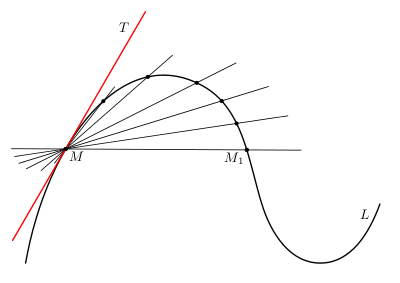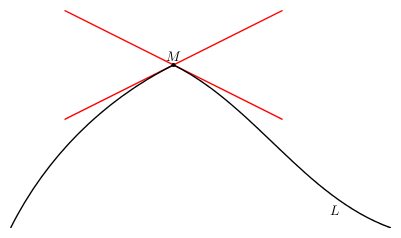|
|
| (8 intermediate revisions by 2 users not shown) |
| Line 1: |
Line 1: |
| | ''to a curve'' | | ''to a curve'' |
| | | | |
| − | A straight line representing the limiting position of the secants. Let <img align="absmiddle" border="0" src="https://www.encyclopediaofmath.org/legacyimages/t/t092/t092170/t0921701.png" /> be a point on a curve <img align="absmiddle" border="0" src="https://www.encyclopediaofmath.org/legacyimages/t/t092/t092170/t0921702.png" /> (Fig. a). A second point <img align="absmiddle" border="0" src="https://www.encyclopediaofmath.org/legacyimages/t/t092/t092170/t0921703.png" /> is chosen on <img align="absmiddle" border="0" src="https://www.encyclopediaofmath.org/legacyimages/t/t092/t092170/t0921704.png" /> and the straight line <img align="absmiddle" border="0" src="https://www.encyclopediaofmath.org/legacyimages/t/t092/t092170/t0921705.png" /> is drawn. The point <img align="absmiddle" border="0" src="https://www.encyclopediaofmath.org/legacyimages/t/t092/t092170/t0921706.png" /> is regarded as fixed, and <img align="absmiddle" border="0" src="https://www.encyclopediaofmath.org/legacyimages/t/t092/t092170/t0921707.png" /> approaches <img align="absmiddle" border="0" src="https://www.encyclopediaofmath.org/legacyimages/t/t092/t092170/t0921708.png" /> along the curve <img align="absmiddle" border="0" src="https://www.encyclopediaofmath.org/legacyimages/t/t092/t092170/t0921709.png" />. If, as <img align="absmiddle" border="0" src="https://www.encyclopediaofmath.org/legacyimages/t/t092/t092170/t09217010.png" /> goes to <img align="absmiddle" border="0" src="https://www.encyclopediaofmath.org/legacyimages/t/t092/t092170/t09217011.png" />, the line <img align="absmiddle" border="0" src="https://www.encyclopediaofmath.org/legacyimages/t/t092/t092170/t09217012.png" /> tends to a limiting line <img align="absmiddle" border="0" src="https://www.encyclopediaofmath.org/legacyimages/t/t092/t092170/t09217013.png" />, then <img align="absmiddle" border="0" src="https://www.encyclopediaofmath.org/legacyimages/t/t092/t092170/t09217014.png" /> is called the tangent to <img align="absmiddle" border="0" src="https://www.encyclopediaofmath.org/legacyimages/t/t092/t092170/t09217015.png" /> at <img align="absmiddle" border="0" src="https://www.encyclopediaofmath.org/legacyimages/t/t092/t092170/t09217016.png" />.
| + | {{MSC|53|58}} |
| | + | {{TEX|done}} |
| | | | |
| − | <img style="border:1px solid;" src="https://www.encyclopediaofmath.org/legacyimages/common_img/t092170a.gif" /> | + | $\newcommand{\vect}[1]{\mathbf{#1}}$ |
| | + | <span id="Fig1"> |
| | + | [[File:Tangent-line-1.png| right| frame| Figure 1. The tangent $MT$ (in red) to the line $L$ at the point $M$ ([[Media:Tangent-line-1.pdf|pdf]]) ]] |
| | + | </span> |
| | + | The tangent line to a curve is |
| | + | a straight line representing the limiting position of the secants. Let $M$ be a point on a curve $L$ ([[#Fig1|Fig. 1]]). A second point $M_1$ is chosen on $L$ and the straight line $M_1$ is drawn. The point $M$ is regarded as fixed, and $M_1$ approaches $M$ along the curve $L$. If, as $M_1$ goes to $M$, the line $MM_1$ tends to a limiting line $MT$, then $MT$ is called the tangent to $L$ at $M$. |
| | | | |
| − | Figure: t092170a | + | <span id="Fig2"> |
| | + | [[File:Tangent-line-2.png| right| frame| Figure 2. A curve $L$ and point $M$ on it without a tangent ([[Media:Tangent-line-2.pdf|pdf]]) ]] |
| | + | </span> |
| | + | Not every continuous curve has a tangent, since $MM_1$ need not tend to a limiting position at all, or it may tend to two distinct limiting positions as $M_1$ tends to $M$ from different sides of $L$ ([[#Fig2|Fig. 2]]). |
| | | | |
| − | <img style="border:1px solid;" src="https://www.encyclopediaofmath.org/legacyimages/common_img/t092170b.gif" />
| + | If a curve in the plane with rectangular coordinates is defined by the equation $y=f(x)$ and $f$ is differentiable at the point $x_0$, then the slope of the tangent at $M$ is equal to the value of the derivative $f^\prime(x_0)$ at $x_0$; the equation of the tangent at this point has the form |
| | + | $$ |
| | + | y - f(x_0) = f^\prime(x_0)(x - x_0). |
| | + | $$ |
| | + | The equation of the tangent to a curve $\vect{r} = \vect{r}(t)$ in space is |
| | + | $$ |
| | + | \vect{t}(\lambda) = |
| | + | \vect{r} + \lambda \frac{\mathrm{d}\vect{r}}{\mathrm{d}t}, \quad |
| | + | \lambda \in \R. |
| | + | $$ |
| | | | |
| − | Figure: t092170b
| + | By a tangent to a surface $S$ at a point $M$ one means a straight line passing through $M$ and lying in the [[Tangent plane|tangent plane]] to $S$ at $M$. |
| | | | |
| − | Not every continuous curve has a tangent, since <img align="absmiddle" border="0" src="https://www.encyclopediaofmath.org/legacyimages/t/t092/t092170/t09217017.png" /> need not tend to a limiting position at all, or it may tend to two distinct limiting positions as <img align="absmiddle" border="0" src="https://www.encyclopediaofmath.org/legacyimages/t/t092/t092170/t09217018.png" /> tends to <img align="absmiddle" border="0" src="https://www.encyclopediaofmath.org/legacyimages/t/t092/t092170/t09217019.png" /> from different sides of <img align="absmiddle" border="0" src="https://www.encyclopediaofmath.org/legacyimages/t/t092/t092170/t09217020.png" /> (Fig. b). If a curve in the plane with rectangular coordinates is defined by the equation <img align="absmiddle" border="0" src="https://www.encyclopediaofmath.org/legacyimages/t/t092/t092170/t09217021.png" /> and <img align="absmiddle" border="0" src="https://www.encyclopediaofmath.org/legacyimages/t/t092/t092170/t09217022.png" /> is differentiable at the point <img align="absmiddle" border="0" src="https://www.encyclopediaofmath.org/legacyimages/t/t092/t092170/t09217023.png" />, then the slope of the tangent at <img align="absmiddle" border="0" src="https://www.encyclopediaofmath.org/legacyimages/t/t092/t092170/t09217024.png" /> is equal to the value of the derivative <img align="absmiddle" border="0" src="https://www.encyclopediaofmath.org/legacyimages/t/t092/t092170/t09217025.png" /> at <img align="absmiddle" border="0" src="https://www.encyclopediaofmath.org/legacyimages/t/t092/t092170/t09217026.png" />; the equation of the tangent at this point has the form
| + | ====References==== |
| | | | |
| − | <table class="eq" style="width:100%;"> <tr><td valign="top" style="width:94%;text-align:center;"><img align="absmiddle" border="0" src="https://www.encyclopediaofmath.org/legacyimages/t/t092/t092170/t09217027.png" /></td> </tr></table>
| + | {| |
| − | | + | |- |
| − | The equation of the tangent to a curve <img align="absmiddle" border="0" src="https://www.encyclopediaofmath.org/legacyimages/t/t092/t092170/t09217028.png" /> in space is
| + | |valign="top"|{{Ref|BeGo}}||valign="top"| M. Berger, B. Gostiaux, "Differential geometry: manifolds, curves, and surfaces", Springer (1988) (Translated from French) {{MR|0917479}} {{ZBL|0629.53001}} |
| − | | + | |- |
| − | <table class="eq" style="width:100%;"> <tr><td valign="top" style="width:94%;text-align:center;"><img align="absmiddle" border="0" src="https://www.encyclopediaofmath.org/legacyimages/t/t092/t092170/t09217029.png" /></td> </tr></table>
| + | |valign="top"|{{Ref|Co}}||valign="top"| H.S.M. Coxeter, "Introduction to geometry", Wiley (1961) {{MR|1531486}} {{MR|0123930}} {{ZBL|0095.34502}} |
| − | | + | |- |
| − | By a tangent to a surface <img align="absmiddle" border="0" src="https://www.encyclopediaofmath.org/legacyimages/t/t092/t092170/t09217030.png" /> at a point <img align="absmiddle" border="0" src="https://www.encyclopediaofmath.org/legacyimages/t/t092/t092170/t09217031.png" /> one means a straight line passing through <img align="absmiddle" border="0" src="https://www.encyclopediaofmath.org/legacyimages/t/t092/t092170/t09217032.png" /> and lying in the [[Tangent plane|tangent plane]] to <img align="absmiddle" border="0" src="https://www.encyclopediaofmath.org/legacyimages/t/t092/t092170/t09217033.png" /> at <img align="absmiddle" border="0" src="https://www.encyclopediaofmath.org/legacyimages/t/t092/t092170/t09217034.png" />.
| + | |valign="top"|{{Ref|Gu}}||valign="top"| H.W. Guggenheimer, "Differential geometry", McGraw-Hill (1963) {{MR|0156266}} {{ZBL|0116.13402}} |
| − | | + | |- |
| − | | + | |valign="top"|{{Ref|HiCo}}||valign="top"| D. Hilbert, S.E. Cohn-Vossen, "Geometry and the imagination", Chelsea (1952) (Translated from German) {{MR|0046650}} {{ZBL|0047.38806}} |
| − | | + | |- |
| − | ====Comments====
| + | |} |
| − | | |
| − | | |
| − | ====References====
| |
| − | <table><TR><TD valign="top">[a1]</TD> <TD valign="top"> M. Berger, B. Gostiaux, "Differential geometry: manifolds, curves, and surfaces" , Springer (1988) (Translated from French)</TD></TR><TR><TD valign="top">[a2]</TD> <TD valign="top"> H.S.M. Coxeter, "Introduction to geometry" , Wiley (1961)</TD></TR><TR><TD valign="top">[a3]</TD> <TD valign="top"> H.W. Guggenheimer, "Differential geometry" , McGraw-Hill (1963)</TD></TR><TR><TD valign="top">[a4]</TD> <TD valign="top"> D. Hilbert, S.E. Cohn-Vossen, "Geometry and the imagination" , Chelsea (1952) (Translated from German)</TD></TR><TR><TD valign="top">[a5]</TD> <TD valign="top"> B. O'Neill, "Elementary differential geometry" , Acad. Press (1966)</TD></TR></table>
| |
to a curve
2020 Mathematics Subject Classification: Primary: 53-XX Secondary: 58-XX [MSN][ZBL]
$\newcommand{\vect}[1]{\mathbf{#1}}$

Figure 1. The tangent $MT$ (in red) to the line $L$ at the point $M$ (
pdf)
The tangent line to a curve is
a straight line representing the limiting position of the secants. Let $M$ be a point on a curve $L$ (Fig. 1). A second point $M_1$ is chosen on $L$ and the straight line $M_1$ is drawn. The point $M$ is regarded as fixed, and $M_1$ approaches $M$ along the curve $L$. If, as $M_1$ goes to $M$, the line $MM_1$ tends to a limiting line $MT$, then $MT$ is called the tangent to $L$ at $M$.

Figure 2. A curve $L$ and point $M$ on it without a tangent (
pdf)
Not every continuous curve has a tangent, since $MM_1$ need not tend to a limiting position at all, or it may tend to two distinct limiting positions as $M_1$ tends to $M$ from different sides of $L$ (Fig. 2).
If a curve in the plane with rectangular coordinates is defined by the equation $y=f(x)$ and $f$ is differentiable at the point $x_0$, then the slope of the tangent at $M$ is equal to the value of the derivative $f^\prime(x_0)$ at $x_0$; the equation of the tangent at this point has the form
$$
y - f(x_0) = f^\prime(x_0)(x - x_0).
$$
The equation of the tangent to a curve $\vect{r} = \vect{r}(t)$ in space is
$$
\vect{t}(\lambda) =
\vect{r} + \lambda \frac{\mathrm{d}\vect{r}}{\mathrm{d}t}, \quad
\lambda \in \R.
$$
By a tangent to a surface $S$ at a point $M$ one means a straight line passing through $M$ and lying in the tangent plane to $S$ at $M$.
References
| [BeGo] |
M. Berger, B. Gostiaux, "Differential geometry: manifolds, curves, and surfaces", Springer (1988) (Translated from French) MR0917479 Zbl 0629.53001
|
| [Co] |
H.S.M. Coxeter, "Introduction to geometry", Wiley (1961) MR1531486 MR0123930 Zbl 0095.34502
|
| [Gu] |
H.W. Guggenheimer, "Differential geometry", McGraw-Hill (1963) MR0156266 Zbl 0116.13402
|
| [HiCo] |
D. Hilbert, S.E. Cohn-Vossen, "Geometry and the imagination", Chelsea (1952) (Translated from German) MR0046650 Zbl 0047.38806
|

